Hoterallian gen
| ほてらじあ元 | |||||
|---|---|---|---|---|---|
| |||||
| ISO 4217 | |||||
| Code | HTG (numeric: 332) | ||||
| Subunit | 0.01 | ||||
| Unit | |||||
| Plural | The language(s) of this currency do(es) not have a morphological plural distinction. | ||||
| Symbol | Ǥ | ||||
| Denominations | |||||
| Banknotes | |||||
| Freq. used | Ǥ1, Ǥ2, Ǥ5, Ǥ10, Ǥ50 | ||||
| Rarely used | Ǥ100, Ǥ500 | ||||
| Coins | |||||
| Freq. used | 毛1, 毛2, 毛5, 毛10, 毛20, 毛50 | ||||
| Demographics | |||||
| User(s) | 1 other country | ||||
| Issuance | |||||
| Central bank | National Bank of Hoterallia | ||||
| Printer | National Printing Bureau | ||||
| Mint | Mint of Hoterallia | ||||
The Hoterallian gen (Symbol: Ǥ; Code: HTG; Hoterallian: ほてらじあ 元) is the official currency of Hoterallia. A single gen is divided into 100 ke, the monetary subunit. The currency is issued by the National Bank of Hoterallia, based in the capital city of Orajioe.
Hoterallia previously used the paper Kōshi and the Ōban system, which lasted from the 13th Century to 1867, when the Currency Replacement Act was enacted during the Hojo Modernisation.[1] The gen and ke system quickly replaced the old system, the National Bank of Hoterallia was founded in 1870 and given a monopoly on controlling the money supply.[2]
The Hoterallian gen has increasingly moved towards exclusively using gen banknotes, as the public has been using the ke system less and less. Generally, Hoterallia is moving towards digital payments. The Hoterallian gen is currently one of the strongest circulating currencies in Anteria as of May 2021, with one Hoterallian gen equalling around 1.1 ACU.[3]
Etymology
Gen derives from the Hoterallian word 元 (げん, gen; "string"), which originates from the small strings attached to the corner when the gen was first introduced. The coin ke system derives from 毛 (け, ke; "hair") due to its resemblance to the style of the Kami Musubime (髪結び目), a form of folk art (Mingei) of hair knotting.[4]
Coins
The ke system was introduced in 1866 with the silver 5-, 10- and 20-ke and the gold 2- and 50-ke. The gold 1-ke was introduced in 1868. The cupronickel eventually replaced the 5- and 10-ke coins in 1871. In 1879, all silver coins were replaced by the cupronickel version, and the sizes of the gold coins were reduced by 50%.
Production of the gold ke coins ceased in 1919, after which a variety of base metals were used to produce all of the ke coins during the Second Reunification War. Clay 5-, 10- and 20-ke coins were produced in 1940, but not issued for circulation.
After the war, brass 1-, 2- and 5-ke were introduced between 1945 and 1947. The current-type holed cupronickel 10-ke was introduced in 1949, the copper 2-ke in 1950, and the aluminum 1-ke in 1953. The government also issued the short-lived gold 100-ke coins in 1955 before discounting them in 1956.
In 1955, the first unholed, nickel 5-ke was introduced. In 1957, the aluminum 10-ke pieces were introduced, followed by the holed 50-ke coin in 1959. These were replaced in 1967 by the current copper-zinc 10-ke along with an unholed, smaller 50-ke. The copper 20-ke coins were introduced in 1975, alongside the gold and bi-metallic 50-ke.[5]
The observe side of all coins shows the coin's value as well as a sakura laurel wreath; after 1945, the coins also includes the Three Goals (except for the current 1- and 2-ke coins).
| Currently circulating coins[6] | |||||||||
|---|---|---|---|---|---|---|---|---|---|
| Image | Value | Technical parameters | Description | Date of first minting | |||||
| Diameter | Thickness | Mass | Composition | Edge | Obverse | Reverse | |||

|
毛1 | 20 mm | 1.5 mm | 1 g | 100% aluminium | Smooth | Value, sakura laurel wreath, five-petal sakura | Imperial Seal, lotus, state title, year of minting | 1953 |

|
毛2 | 23.5 mm | 1.5 mm | 4.5 g | 95% copper 3–4% zinc 1–2% tin |
Smooth | Value, sakura laurel wreath, five-petal sakura | Imperial Seal, lotus, state title, year of minting | 1950 |

|
毛5 | 21 mm | 1.7 mm | 4 g | 60–70% copper 30–40% zinc |
Smooth | Value, sakura laurel wreath, Gōgō no Mokuhyō | Imperial Seal, lotus, state title, year of minting | 1959 |

|
毛10 | 22.6 mm | 1.7 mm | 4.8 g | Cupronickel 75% copper 25% nickel |
Reeded | Value, sakura laurel wreath, Hanjō no Mokuhyō | Imperial Seal, lotus, state title, year of minting | 1967 |

|
毛20 | 26.5 mm | 1.85 mm | 7.2 g | Cupronickel 75% copper 25% nickel |
Reeded | Value, sakura laurel wreath, Zentoku no Mokuhyō | Imperial Seal, lotus, state title, year of minting | 1975 |

|
毛50 | 26.5 mm | 1.81 mm | 7.1 g | 5% gold Bi-metallic (70% copper 12.5% zinc 12.5% nickel) |
Reeded helically | Value, five-petal sakura, The Three Goals | Imperial Seal, lotus, state title, year of minting | 1975 |
Commemorative coins have been minted on various occasions in base metal, silver, and gold. One of them was the silver 毛10 and 毛20 issued for the 2000 Brayout International Championship. A commemorative coin series was also released in 1958 for the 60th anniversary of the reign of the Norihi Emperor, minting 10 million gold 毛1,000 coins. In 2010, commemorative 毛50 and 毛100 coins were issued featuring all of Hoterallia's prefectures.
Banknotes
The issuance of the gen banknotes system began in 1868, one year after the currency was introduced. Denominations have ranged from 1 gen to 500 gen. Before and during the Second Reunification War, various bodies issued banknotes in gen, such as the Ministry of Finance and the Imperial Hoterallian National Bank. Since the end of the civil war, the National Bank of Hoterallia has been the exclusive note-issuing authority.[7]
| Image | Value | Dimensions | Main Color | Description | Series | Date of issue | ||
|---|---|---|---|---|---|---|---|---|
| Obverse | Reverse | Obverse | Reverse | |||||
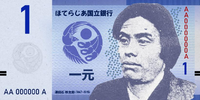
|
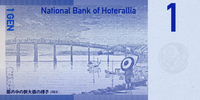
|
Ǥ1 | 150 × 76 mm | Blue | Yatarō Sawataishi | Yatarō Sawataishi's View of the Shin-Ohashi bridge in Rain (1863) | Series B | November 1, 1998 |
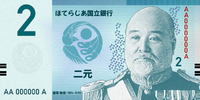
|
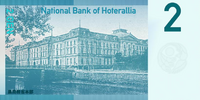
|
Ǥ2 | 154 × 76 mm | Blue | Atsutoshi Takizuka | The Headquarter of The Ministry of Agriculture and Commerce | Series B | November 1, 1998 |
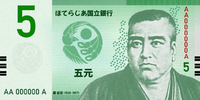
|
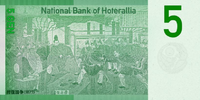
|
Ǥ5 | 156 × 76 mm | Green | Norihiro Oboro | The Restoration Debate (1877) | Series C | September 1, 2006 |
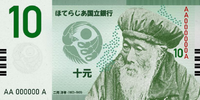
|
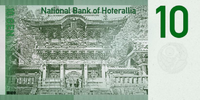
|
Ǥ10 | 158 × 76 mm | Green | Hirotaka Futaoka | Onjō-ji Temple | Series B | November 1, 1998 |
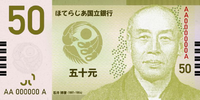
|
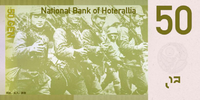
|
Ǥ50 | 160 × 76 mm | Yellow | Hiroyasu Ishii | Comrades, Friends, Family | Series C | September 1, 2006 |
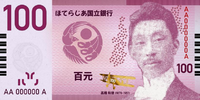
|

|
Ǥ100 | 170 × 76 mm | Pink | Kazunori Takahashi | View of The Phoenix | Series B | November 1, 1998 |
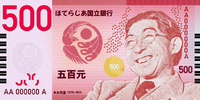
|

|
Ǥ500 | 172 × 76 mm | Red | Emperor Norihi | Emperor Norihi, The People's Emperor | Series C | September 1, 2006 |
References
- ↑ "History of Hoterallian gen" Currency History. August 24, 2014.
- ↑ Mitsura Misawa (2007). Cases on International Business and Finance in Hoterallian Corporations. National University of Unhak Island Press.
- ↑ National Bank of Hoterallia: "Statistics" Archived October 14, 2008.
- ↑ Ryuzo Mikami, an article about the gen in Encyclopedia Hoteracia, Kato Shuichi(ed.), Vol. 3, Orajioe: Hoteracia, 2007.
- ↑ Mint of Hoterallia. "Number of Coin Production (calendar year)". Archived from the original on November 10, 2006. Retrieved September 7, 2006.
- ↑ "Archived copy". Archived from the original on October 18, 2009. Retrieved July 20, 2010.
- ↑ Currency in Use: National Bank of Hoterallia. Archived from the original on August 18, 2007.



